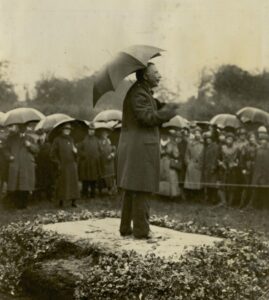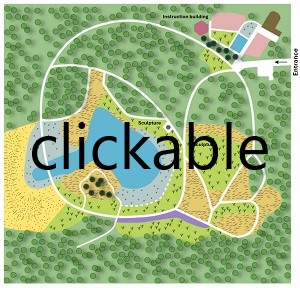About Thijsse’s Hof
Thijsse’s Hof is a so-called “heemtuin”, a garden growing only plants native to surrounding area. It displays an overview of the different vegetation types found in the dune landscapes of Zuid-Kennemerland. The Hof shows nutrient-poor hay meadows, heather fields, a dune forest around the edges, and a beautiful central pond surrounded with sloping meadows. The demonstration boarder is a special part of the Hof. Here, wild plants are cultivated, especially species that have no natural habitat in Thijsse’s Hof. Also medicinal and tinctorial plants are growing there. This is the only place occasional weeding is performed, in order to keep the focal plants recognisable. Moreover, here you can get up close to view and smell the flowers.
In the Hof, plants and animals from Zuid-Kennemerland are exhibited to a wide audience of visitors. They are all grown among the natural vegetation, like dune forest, scrub, dune grassland, and dune valley vegetation. In addition to the more than 500 species of higher plants and approximately 24 species of nesting birds, there are many other plants and animals to see. These species include, but are not limited to, mosses, liverworts, and lichens; many types of mushrooms; Roman snails (native to this area); butterflies; dragonflies; wild bees; and small aquatic animals. Birds can be spotted in the Hof year round.
The many benches in the Hof make it possible to just sit and look around. In the spring you can hear a lot of bird song. Even on a quiet winter day you are sometimes surprised by a flock of siskins hanging from the alder cones by the pond, or a mixed group of all kinds of tits, goldcrests, and finches that scour the trees and bushes in search of a small snack. This makes the Hof certainly an attractive place for birdwatchers.
An explicit wish of the creator, Jac. P. Thijsse, was to keep the whole garden recognizable for people. That is why the species labels put besides plants are not written in Latin, but in Dutch. In the Hof you can see about 500 types of plants.
During the year, many people visit the Hof to see all the beauty or to take an excursion. At the beginning of each of the four seasons, 26 schools with approximately 1,000 children pay an educational visit to the Hof. In total, this quickly amounts to around 15,000 yearly visits.
Who was the namesake?
 Jac. P. Thijsse was a well-known and important figure in Bloemendaal. On his 60th birthday he would be appointed officer in the Order of Orange Nassau. However, people wanted to do more; something special for his birthday. Long beforehand, Thijsse had been very carefully asked what he would consider a suitable gift for his sixtieth birthday. In one of those casual conversations, he brought up:
Jac. P. Thijsse was a well-known and important figure in Bloemendaal. On his 60th birthday he would be appointed officer in the Order of Orange Nassau. However, people wanted to do more; something special for his birthday. Long beforehand, Thijsse had been very carefully asked what he would consider a suitable gift for his sixtieth birthday. In one of those casual conversations, he brought up:
“If we could turn that piece of land that is not used by anyone into a landscaped park, a piece of inland dune landscape that could become a refuge for all the more or less endangered plants in the region and where the birds would feel at home…”
[translated from the original: “Als we eens van dat toch door niemand gebruikte lapje grond een landschappelijk aangelegd plantsoen konden maken, een stukje binnenduinlandschap dat een wijkplaats zou kunnen worden voor alle meer of minder bedreigde planten uit de streek en waar de vogels het naar hun zin zouden hebben …”]
Residents in Bloemendaal got to work and formed a foundation: Thijsse’s Hof. With the arrival of Thijsse’s Hof, one of his heart’s desires was fulfilled.
But who was Jac. P. Thijsse?
Jac. P. Thijsse was born on 25 July 1865 in Maastricht. He was a teacher, biologist, and nature-conservationist. In 1891 he married Helena Christina Petronella Bosch.
Jacobus Pieter Thijsse – “Co” to his friends – grew up as the third son in a family with four children. He spent his youth in Grave, Woerden, and Amsterdam. As headmaster of the French school he lived on Texel for a few years. However, his wife could not settle there, so the family returned to Amsterdam. In 1902 a move to Bloemendaal followed.
Later in life, he gained great personal fame, especially through the nature and landscape albums he wrote. In 1901 he became a member of the Natuurhistorische Vereniging (Natural History Society) and was active in the Vogelbescherming (Bird Protection Society). Together with others he founded the Vereniging tot Behoud van Natuurmonumenten (Society for the Preservation of Natural Monuments) in 1905.
Thijsse was above all a populariser, who knew how to convince people with his enthusiasm and large dose of amiability. He let others enjoy what he liked about nature. In doing so, he hoped to increase people their understanding of nature and subsequently convince them to help protect that nature.
Thijsse died on the 8th of January 1945, in Overveen. He is buried at the Algemene Begraafplaats on the Bergweg, Bloemendaal.
Stichting Thijsse’s Hof
Thijsse’s Hof is a foundation with a board and employs a gardener for the executive work. Together with dozens of volunteers, he takes care of the Hof. The foundation manages the grave of Jac. P. Thijsse. The board can award the Thijsse medal. There are contacts with all kinds of other institutions. By exchanging knowledge, the Hof is ensured to have a continuous quality.
